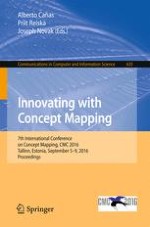2016 | Book
Innovating with Concept Mapping
7th International Conference on Concept Mapping, CMC 2016, Tallinn, Estonia, September 5-9, 2016, Proceedings
Editors: Alberto Cañas, Priit Reiska, Joseph Novak
Publisher: Springer International Publishing
Book Series : Communications in Computer and Information Science
